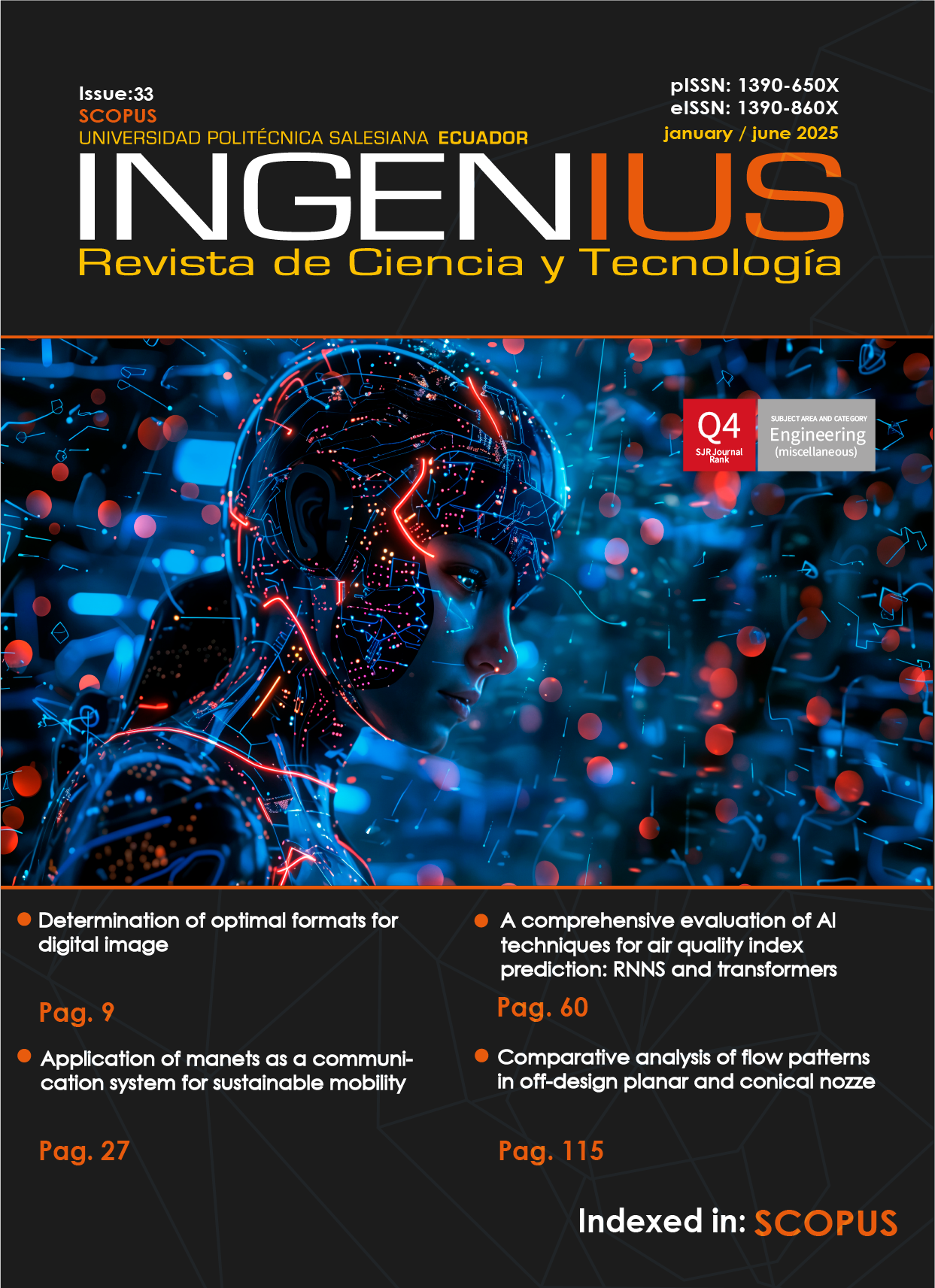Convolutional neural networks for diabetic retinopathy detection
Main Article Content
Abstract
Article Details

This work is licensed under a Creative Commons Attribution-NonCommercial-ShareAlike 4.0 International License.
The Universidad Politécnica Salesiana of Ecuador preserves the copyrights of the published works and will favor the reuse of the works. The works are published in the electronic edition of the journal under a Creative Commons Attribution/Noncommercial-No Derivative Works 4.0 Ecuador license: they can be copied, used, disseminated, transmitted and publicly displayed.
The undersigned author partially transfers the copyrights of this work to the Universidad Politécnica Salesiana of Ecuador for printed editions.
It is also stated that they have respected the ethical principles of research and are free from any conflict of interest. The author(s) certify that this work has not been published, nor is it under consideration for publication in any other journal or editorial work.
The author (s) are responsible for their content and have contributed to the conception, design and completion of the work, analysis and interpretation of data, and to have participated in the writing of the text and its revisions, as well as in the approval of the version which is finally referred to as an attachment.
References
OMS, TADDS* Instrumento para la evaluación de los sistemas de atención a la diabetes y a la retinopatía diabética. Organización Mundial de la Salud, 2015. [Online]. Available: https://upsalesiana.ec/ing33ar8r1
L. García Ferrer, M. Ramos López, Y. Molina Santana, M. Chang Hernández, E. Perera Miniet, and K. Galindo Reydmond, “Estrategias en el tratamiento de la retinopatía diabética,” Revista Cubana de Oftalmología, vol. 31, pp. 90–99, 03 2018. [Online]. Available: https://upsalesiana.ec/ing33ar8r2
F. Tablado. (2020) Inteligencia artificial en el trabajo ¿cómo afecta la ia al ámbito laboral de las empresas? Grupo Artico34. [Online]. Available: https://upsalesiana.ec/ing33ar8r3
E. W. Steyerberg, A. J. Vickers, N. R. Cook, T. Gerds, M. Gonen, N. Obuchowski, M. J. Pencina, and M. W. Kattan, “Assessing the performance of prediction models: a framework for some traditional and novel measures,” PubMed Central, vol. 21, no. 1, pp. 128–138, 2010. [Online]. Available: https://doi.org/10.1097/EDE.0b013e3181c30fb2
L. Rouhiainen, Inteligencia Artificial: 101 cosas que debes saber hoy sobre nuestro futuro. Editorial Alienta, 2018. [Online]. Available: https://upsalesiana.ec/ing33ar8r5
Y. LeCun, Y. Bengio, and G. Hinton, “Deep learning,” Nature, vol. 521, no. 7553, pp. 436–444, May 2015. [Online]. Available: https://doi.org/10.1038/nature14539
J. M. Sanchez Muñoz, “Análisis de calidad cartográfica mediante el estudio de la matriz de confusión,” Pensamiento Matematico, vol. 6, no. 2, pp. 9–26, 2016. [Online]. Available: https://upsalesiana.ec/ing33ar8r13
X. Ou, P. Yan, Y. Zhang, B. Tu, G. Zhang, J. Wu, and W. Li, “Moving object detection method via resnet-18 with encoder–decoder structure in complex scenes,” IEEE Access, vol. 7, pp. 108 152–108 160, 2019. [Online]. Available: https://doi.org/10.1109/ACCESS.2019.2931922
G. Celano, “A resnet-50-based convolutional neural network model for language id identification from speech recordings,” ACL Anthology, 2021. [Online]. Available: https://upsalesiana.ec/ing33ar8r8
E. Todt and B. A. Krinski, Convolutional Neural Network–CNN. Universidade Federal do Paraná, 2019. [Online]. Available: https://upsalesiana.ec/ing33ar8r9
J. Torres, DEEP LEARNING Introducción práctica con Keras. LuLu, 2018. [Online]. Available: https://upsalesiana.ec/ing33ar8r10
C. Zhu, C. U. Idemudia, and W. Feng, “Improved logistic regression model for diabetes prediction by integrating pca and k-means techniques,” Informatics in Medicine Unlocked, vol. 17, p. 100179, 2019. [Online]. Available: https://doi.org/10.1016/j.imu.2019.100179
C. Bonilla Carrion, Redes Convolucionales. Trabajo Fin de Grado Inédito. Universidad de Sevilla, 2020. [Online]. Available: https://upsalesiana.ec/ing33ar8r12
D. Anguita, L. Ghelardoni, A. Ghio, L. Oneto, and S. Ridella, “The ‘k’ in k–fold cross validationthe ‘k’ in k-fold cross validation,” in European Symposium on Artificial Neural Networks, Computational Intelligenceand Machine Learning, 2012. [Online]. Available: https://upsalesiana.ec/ing33ar8r15
L. Herguedas Fenoy, Guía práctica clínica para la realización de una retinografía. Universidad de Valladolid, 2018. [Online]. vailable:
https://upsalesiana.ec/ing33ar8r17
J. Chua, C. X. Y. Lim, T. Y. Wong, and C. Sabanayagam, “Diabetic retinopathy in the asiapacific,” Asia-Pacific Journal of Ophthalmology, vol. 7, no. 1, pp. 3–16, 2018. [Online]. Available: https://doi.org/10.22608/APO.2017511
G. Stiglic, P. Kocbek, N. Fijacko, M. Zitnik, K. Verbert, and L. Cilar, “Interpretability of machine learning-based prediction models in healthcare,” WIREs Data Mining and Knowledge Discovery, vol. 10, no. 5, p. e1379, 2020. [Online]. Available: https://doi.org/10.1002/widm.1379
Z.-H. Zhou, “A brief introduction to weakly supervised learning,” National Science Review, vol. 5, no. 1, pp. 44–53, Jan 2018. [Online]. Available: https://doi.org/10.1093/nsr/nwx106
J. Wu, Introduction to Convolutional Neural Networks. LAMDA Group, 2017. [Online]. Available: https://upsalesiana.ec/ing33ar8r22
R. Gonzalez Gouveia, Diferencias entre Inteligencia Artificial vs Machine Learning vs Deep Learning. YouTube, 2021. [Online]. Available: https://upsalesiana.ec/ing33ar8r23
G. Hinton, O. Vinyals, and J. Dean, “Distilling the knowledge in a neural network,” arXiv, 03 2015. [Online]. Available: https://upsalesiana.ec/ing33ar8r24

